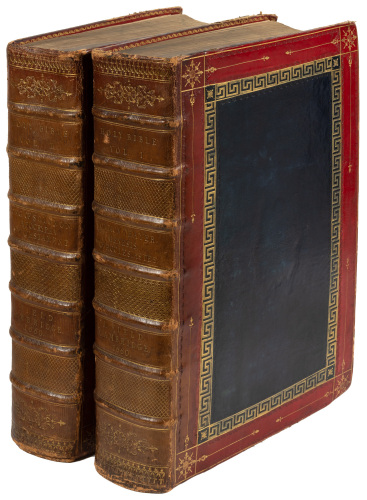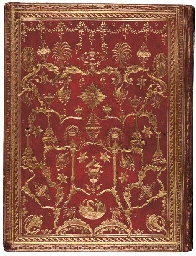THE BOOK OF JOHN MANDEVILLE , or, Sir John Mandeville's Travels , in Middle English, ILLUMINATED MANUSCRIPT ON VELLUM
THE BOOK OF JOHN MANDEVILLE , or, Sir John Mandeville's Travels , in Middle English, ILLUMINATED MANUSCRIPT ON VELLUM [?London, c.1440] 220 x 145mm. 64ff: 1 7 + 1 , 2-7 8 , 8 8 (of 10), catchwords on final versos, original text and gatherings COMPLETE, 31-32 lines of cursive anglicana written in brown ink, contemporary sidenotes and nota marks in red in the first four leaves, later sidenotes and nota marks in various hands from f.34v to end, opening illuminated initial with ivy-leaf sprays into margins and 17 blue initials with extensive red penwork flourishing, three contemporary or near contemporary marginal drawings, one with colour wash, manicula in margins of ff.3, 24v, 57, marginal annotations in several hands of the 15th to 17th centuries (cropping affecting sprays of opening illuminated intitial and some side notes, staining and darkening, mainly to margins and not affecting legibility, cut near gutter in lower half of f.9). English 18th-century mottled calf gilt (joints split, some abrasion to covers and extremities rubbed). THE 'LOST' MANUSCRIPT OF THE MOST POPULAR MEDIEVAL TRAVEL BOOK PROVENANCE: 1. Beneath the end of the text on the penultimate recto is written 'q[uo]d berstede'. This seems most likely to be the scribe's name and his family may have originated in Berstead in Kent. 2. John Theyer (1597-1673), antiquary: his monogram followed by the figure 5 and foliation f o j in his hand on f.1. Theyer bequeathed his collection of 800 manuscripts to his grandson Charles who tried, but failed, to sell them to Oxford University. The manuscripts were then purchased by the London bookseller Robert Scott who sold 312 volumes to Charles II; these are now Royal manuscripts of the British Library. 3. John Barwick of Charing: his inscription is written in a 19th-century hand on the front endleaf. It is likely that this was the Reverend John Barwick who was vicar of Charing from 1799. 4. Walter Sneyd (1809-1888); his armorial bookplate pasted inside upper cover and his sale Sotheby's 16 December 1903, lot 495. 5. Sir Thomas Brooke 1st Baronet of Armitage Bridge (1830-1908): his armorial bookplate on front endpaper. Although his large and important collection is best known for the 170 volumes from the library of the Pillone family, with fore-edge paintings by Cesare Vecellio it was of even greater significance for the wide range of manuscripts it contained. 6. Sir John Arthur Brooke: his sale Sotheby's 25 May 1921, lot 921. 7. Sir R. Leicester Harmsworth: his sale Sotheby's 15 October 1945, lot 2023. CONTENT: The Book of John Mandeville , in Middle English ff.1-65; Biblical quotations in Middle English, a near contemporary addition, ff.65v-66v apparently defective at end. Purporting to be the account by a knight from St Albans of his journey to the Holy Land and beyond, The Book of John Mandeville , or the Travels of Sir John Mandeville as it was later known, was originally written in French in the middle of the 14th century. The immediacy of its style and the colourful and exotic information it offered led to a speedy, widespread and enduring popularity: within fifty years The Book was circulating on both sides of the Channel and was known in eight languages. Its appeal persisted -- it was consulted by Columbus and Raleigh, and Dr Johnson praised it for its 'force of thought and beauty of expression': T. Kohanski & C.D. Benson, The Book of John Mandeville , 2007. The Book was, in fact, a compilation made from multiple sources -- around 30 have been identified -- of which the principal are William of Bodensee's Liber de quibusdam ultramarinis partibus of 1336 and Oderic of Pordenone's Relatio of 1330: the first a narrative of the author's pilgrimage to Egypt and the Holy Land, and the second an account of the wonders seen during the friar's decade-long mission to India and China. Both of these works were translated into French in 1351 by Jean le Long of Ypres, monk of St Bertin at Saint Omer, and these were the vers
THE BOOK OF JOHN MANDEVILLE , or, Sir John Mandeville's Travels , in Middle English, ILLUMINATED MANUSCRIPT ON VELLUM
THE BOOK OF JOHN MANDEVILLE , or, Sir John Mandeville's Travels , in Middle English, ILLUMINATED MANUSCRIPT ON VELLUM [?London, c.1440] 220 x 145mm. 64ff: 1 7 + 1 , 2-7 8 , 8 8 (of 10), catchwords on final versos, original text and gatherings COMPLETE, 31-32 lines of cursive anglicana written in brown ink, contemporary sidenotes and nota marks in red in the first four leaves, later sidenotes and nota marks in various hands from f.34v to end, opening illuminated initial with ivy-leaf sprays into margins and 17 blue initials with extensive red penwork flourishing, three contemporary or near contemporary marginal drawings, one with colour wash, manicula in margins of ff.3, 24v, 57, marginal annotations in several hands of the 15th to 17th centuries (cropping affecting sprays of opening illuminated intitial and some side notes, staining and darkening, mainly to margins and not affecting legibility, cut near gutter in lower half of f.9). English 18th-century mottled calf gilt (joints split, some abrasion to covers and extremities rubbed). THE 'LOST' MANUSCRIPT OF THE MOST POPULAR MEDIEVAL TRAVEL BOOK PROVENANCE: 1. Beneath the end of the text on the penultimate recto is written 'q[uo]d berstede'. This seems most likely to be the scribe's name and his family may have originated in Berstead in Kent. 2. John Theyer (1597-1673), antiquary: his monogram followed by the figure 5 and foliation f o j in his hand on f.1. Theyer bequeathed his collection of 800 manuscripts to his grandson Charles who tried, but failed, to sell them to Oxford University. The manuscripts were then purchased by the London bookseller Robert Scott who sold 312 volumes to Charles II; these are now Royal manuscripts of the British Library. 3. John Barwick of Charing: his inscription is written in a 19th-century hand on the front endleaf. It is likely that this was the Reverend John Barwick who was vicar of Charing from 1799. 4. Walter Sneyd (1809-1888); his armorial bookplate pasted inside upper cover and his sale Sotheby's 16 December 1903, lot 495. 5. Sir Thomas Brooke 1st Baronet of Armitage Bridge (1830-1908): his armorial bookplate on front endpaper. Although his large and important collection is best known for the 170 volumes from the library of the Pillone family, with fore-edge paintings by Cesare Vecellio it was of even greater significance for the wide range of manuscripts it contained. 6. Sir John Arthur Brooke: his sale Sotheby's 25 May 1921, lot 921. 7. Sir R. Leicester Harmsworth: his sale Sotheby's 15 October 1945, lot 2023. CONTENT: The Book of John Mandeville , in Middle English ff.1-65; Biblical quotations in Middle English, a near contemporary addition, ff.65v-66v apparently defective at end. Purporting to be the account by a knight from St Albans of his journey to the Holy Land and beyond, The Book of John Mandeville , or the Travels of Sir John Mandeville as it was later known, was originally written in French in the middle of the 14th century. The immediacy of its style and the colourful and exotic information it offered led to a speedy, widespread and enduring popularity: within fifty years The Book was circulating on both sides of the Channel and was known in eight languages. Its appeal persisted -- it was consulted by Columbus and Raleigh, and Dr Johnson praised it for its 'force of thought and beauty of expression': T. Kohanski & C.D. Benson, The Book of John Mandeville , 2007. The Book was, in fact, a compilation made from multiple sources -- around 30 have been identified -- of which the principal are William of Bodensee's Liber de quibusdam ultramarinis partibus of 1336 and Oderic of Pordenone's Relatio of 1330: the first a narrative of the author's pilgrimage to Egypt and the Holy Land, and the second an account of the wonders seen during the friar's decade-long mission to India and China. Both of these works were translated into French in 1351 by Jean le Long of Ypres, monk of St Bertin at Saint Omer, and these were the vers






.jpg)








Try LotSearch and its premium features for 7 days - without any costs!
Be notified automatically about new items in upcoming auctions.
Create an alert